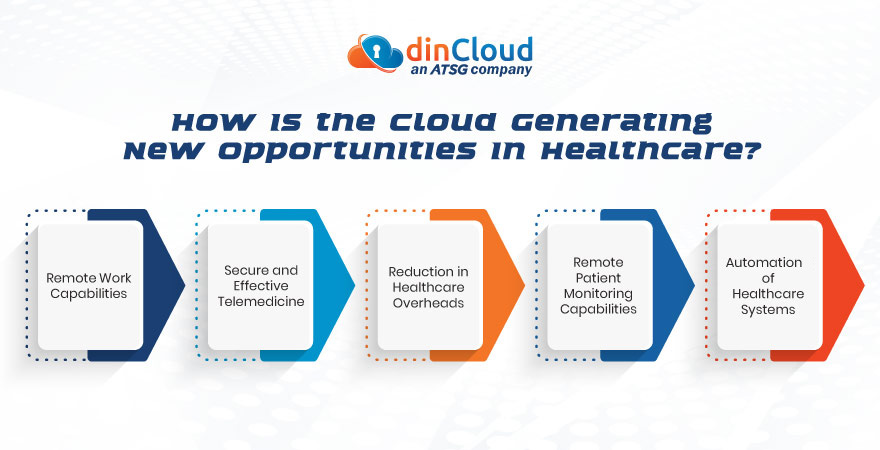Healthcare is one of the most heavily regulated sectors across the globe. However, healthcare providers were also at the forefront of mounting an effective response against the devastating Covid-19 pandemic.

This health crisis of global proportions resulted in the evolution of many industries, and the Healthcare sector was no exception. It is pertinent to mention here that due to stringent regulatory standards and patient privacy concerns, healthcare providers were not among the “early adopters” of Cloud Computing solutions as well as services.
This perception rapidly shifted in favour of Cloud solutions after the pandemic, especially when the cloud infrastructures of leading Cloud Service Providers (CSP) stood the test of time, both in terms of performance, and in maintaining a robust cyber security posture.
In this post, we will discuss some of the major areas where Cloud Computing solutions and services have created immense ease for healthcare providers and patients alike.
Remote Work Capabilities
Healthcare professionals had to bear the brunt of the pandemic’s impact, both in terms of their personal health and from a workload perspective. Healthcare providers were overstretched to previously unseen proportions in recent recorded history.
Amidst all this adversity, Cloud Computing opened a whole new “window of opportunity”, by offering secure, compliant and effective Remote Work capabilities for healthcare professionals. This was particularly helpful for healthcare staff that had non-patient-facing roles within their respective healthcare organizations.
Secure and Effective Telemedicine
Before the mainstreaming of Cloud Computing solutions and services within Telemedicine, this sub-domain of healthcare never really took off. Previously, it was declared insecure, inefficient, and even ineffective in some cases.
Cloud Computing delivered on this account in a whole new way, by offering secure, reliable, responsive and effective telemedicine capabilities to healthcare professionals and patients alike. Telemedicine also played a key role in alleviating the stress levels of healthcare professionals, as they were able to achieve better work/life balance in their lives.
Related Posts:
- How is Cloud Computing Driving Innovative Healthcare?
- Healthcare Industry Digital Technology Resources
- How is the Cloud Leading the Evolution of Healthcare?
Reduction in Healthcare Overheads
The healthcare sector faced a “double-edged sword” after the onset of the pandemic, which came in the form of shrinking budgets, and skyrocketing numbers of patients. Physical space also emerged as a challenge for healthcare institutions, as the pandemic resulted in an unprecedented number of patients in need of hospitalization.
At such odds, Cloud Computing solutions offered cost-efficient alternatives to on-premise healthcare systems. This proved helpful in reducing the overheads, while also freeing up space that was previously reserved for expensive in-house data centres and servers etc.
Remote Patient Monitoring Capabilities
The pandemic also proliferated the trend of remote patient monitoring, by making it secure, compliant, reliable and effective. By connecting specialized remote patient monitoring devices, tailored to their respective medical and health issues, healthcare professionals were able to remotely keep an eye on patients’ wellbeing.
This was also a major source of relieving the already stressed-out healthcare professionals from further work, without compromising on patient wellbeing. By aggregating patient data over Cloud Computing infrastructures, healthcare institutions were also able to gain valuable insights about disease symptoms, cause and effect, progression cycles and most importantly, preventive measures in the first place.
This was made possible, largely by Cloud Computing solutions. The Cloud not only served as a great way for consolidating patient data, but healthcare providers leveraged the immense processing muscle of the Cloud to make tremendous progress in the areas of vaccine development, medical research and the effective treatment of chronic diseases.
Automation of Healthcare Systems
Granted there are many areas of healthcare services where the human element can never be ignored, but there are still a lot of areas where Automation can do wonders. The Cloud is enabling automation of certain healthcare functions, such as streamlining of the hospital’s back-end operations, timely notifications to both patients and healthcare professionals, reminders about follow-ups, timely re-ordering of medicines, and so on.
Cloud Computing solutions are really paving the way for automation, not only within healthcare but in a lot of other sectors as well. This automation is serving two key purposes. Firstly, automation is eliminating the element of human error, which can have serious consequences within a sensitive area such as healthcare.
Secondly, automation is playing a key role in relieving a lot of healthcare professionals from performing repetitive tasks. This in turn reduces their stress and workload levels, so they can focus more on what really matters, and that is the patient’s wellbeing.
Conclusion
The Healthcare sector has done wonders for humanity in general, and the response to the Covid-19 pandemic was something out of the ordinary. Cloud Computing solutions are playing the role of an immense facilitator in the endeavours of healthcare-providing institutions and professionals toward top-quality healthcare.
Contact dinCloud, an ATSG company, for highly secure and compliant Cloud Computing solutions and services for your healthcare institution. Our state-of-the-art data centres comply with some of the best international standards for the safety and privacy of sensitive data like healthcare records.


